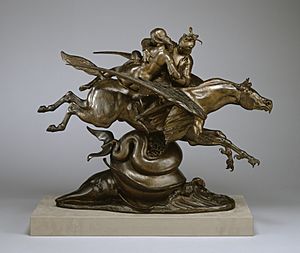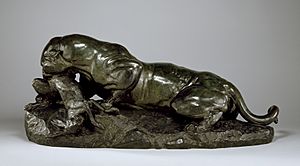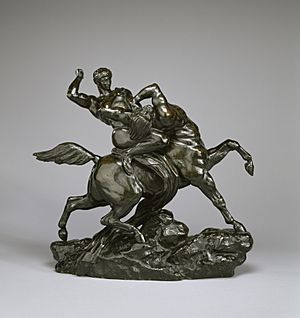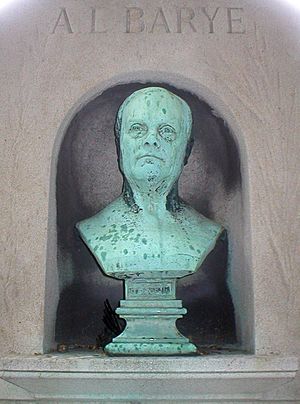Antoine-Louis Barye facts for kids
Quick facts for kids
Antoine-Louis Barye
|
|
|---|---|

Portrait by Léon Bonnat
|
|
| Born | 24 September 1795 |
| Died | 25 June 1875 (aged 79) |
| Education | École des Beaux Arts |
| Occupation | Sculptor |
| Parent(s) | Pierre and Marguerite Barye |
Antoine-Louis Barye (born September 24, 1795 – died June 25, 1875) was a Romantic French sculptor. He is most famous for his work as an animalier, which means he was a sculptor who specialized in making art of animals. His son, Alfred Barye, also became a well-known sculptor.
Contents
Biography
Antoine-Louis Barye was born in Paris, France. He started his career as a goldsmith, just like many other sculptors during the Romantic art period.
He first learned from his father, Pierre. Around 1810, he worked for Guillaume-Mertin Biennais, a goldsmith who worked for Napoleon. Later, in 1816, Barye studied with sculptor Francois-Joseph Bosio and painter Baron Antoine-Jean Gros. In 1818, he was accepted into the École des Beaux-Arts, a famous art school.
It wasn't until 1823 that he found his true passion. While working for another goldsmith, Emile Fauconnier, Barye spent time watching animals at the Jardin des Plantes. This is a large garden in Paris that has a zoo. He made many detailed drawings of the animals, similar to those by the famous artist Delacroix. Then, he started sculpting them in clay, both large and small.
In 1819, while still at the École des Beaux-Arts, Barye created a medallion (a round sculpture) called Milo of Crotana Devoured by a Lion. This sculpture showed a lion biting into Milo's leg. This theme was part of a school competition, and Barye received an honorable mention. Around 1820, he sculpted Hercules with the Erymanthean Boar. This piece showed Hercules capturing a wild boar, which was one of his famous "labors" (tasks).

Barye was very good at sculpting animals, even in small sizes. He captured them in their most natural poses. He also sculpted portraits, like Young Man in a Beret (1823) in bronze, and Portrait of the Founder Richard (1827). In 1829, he created Poised Stag, a larger sculpture that was about 48 centimeters tall.
Barye wanted to be known for more than just small bronze animal sculptures. He wanted to be a sculpteur statuaire, meaning a sculptor of large statues. In 1831, he showed much bigger sculptures. These included Tiger Devouring a Gavial Crocodile, a plaster sculpture that was 41 centimeters high and 103 centimeters long. He also made Lion Crushing a Serpent, a bronze sculpture that was 138 centimeters high and 178 centimeters long. By 1832, he had truly mastered his unique style, which you can see in his famous work, Lion with a Snake.




Even though Barye often struggled with money, he continued to create amazing animal sculptures year after year. His works showed a true sense of romance and a love for ancient art. Some of his famous pieces include Theseus and the Minotaur (1843), Roger and Angelica on the Hippogriff (1846), Lapitha and Centaur (1848), and Jaguar Devouring a Hare (1850). These last two were shown at the Paris Salon in 1850, which was a very important art exhibition. A famous writer, Théophile Gautier, said that Barye "makes him the Michelangelo of the menagerie." This meant Barye was as great at sculpting animals as Michelangelo was at sculpting people.
Some of his larger works include the Lion of the Column of July, created in 1839. He also made various lions and tigers for the gardens of the Tuileries in Paris. In 1854, he created four large groups of sculptures called War, Peace, Strength, and Order.
Barye was an excellent sculptor, but he often had financial problems because he wasn't very good at business. In 1848, he had to declare bankruptcy, and many of his sculptures and molds were sold.
Fame came to Barye later in his life. In 1854, he became a Professor of Drawings at the Museum of Natural History. In 1868, he was elected to the Académie des beaux-arts, a very respected art academy. He stopped creating new works after 1869.
Barye's many wonderful sculptures show that he was one of the greatest animal artists of the French animalier school. He helped make this type of art popular and influenced other sculptors like Emmanuel Frémiet, Paul-Édouard Delabrièrre, Auguste Cain, and Georges Gardet.
There is a public square in Paris, on the eastern tip of Île Saint-Louis, named after him.
Family
Antoine-Louis Barye had a son named Alfred Barye. Alfred studied art with his father and also became an animal sculptor. Even though Alfred was a very skilled sculptor, it was hard for him to become famous because his father was so well-known. Antoine-Louis was not happy when his son started signing his work as "A. Barye." He thought it would confuse people, making them think the work was his. So, he made his son sign his sculptures as "A. Barye, fils" (meaning "A. Barye, son") or "Alf Barye" to show the difference. Antoine-Louis Barye always signed his own bronze sculptures simply as "Barye."
Images for kids
-
Charles VII, the Victorious. The Walters Art Museum.
-
Elephants in Water. The Walters Art Museum.
-
Paris, France. Statue of tiger. Brooklyn Museum Archives, Goodyear Archival Collection.
See also
 In Spanish: Antoine-Louis Barye para niños
In Spanish: Antoine-Louis Barye para niños







